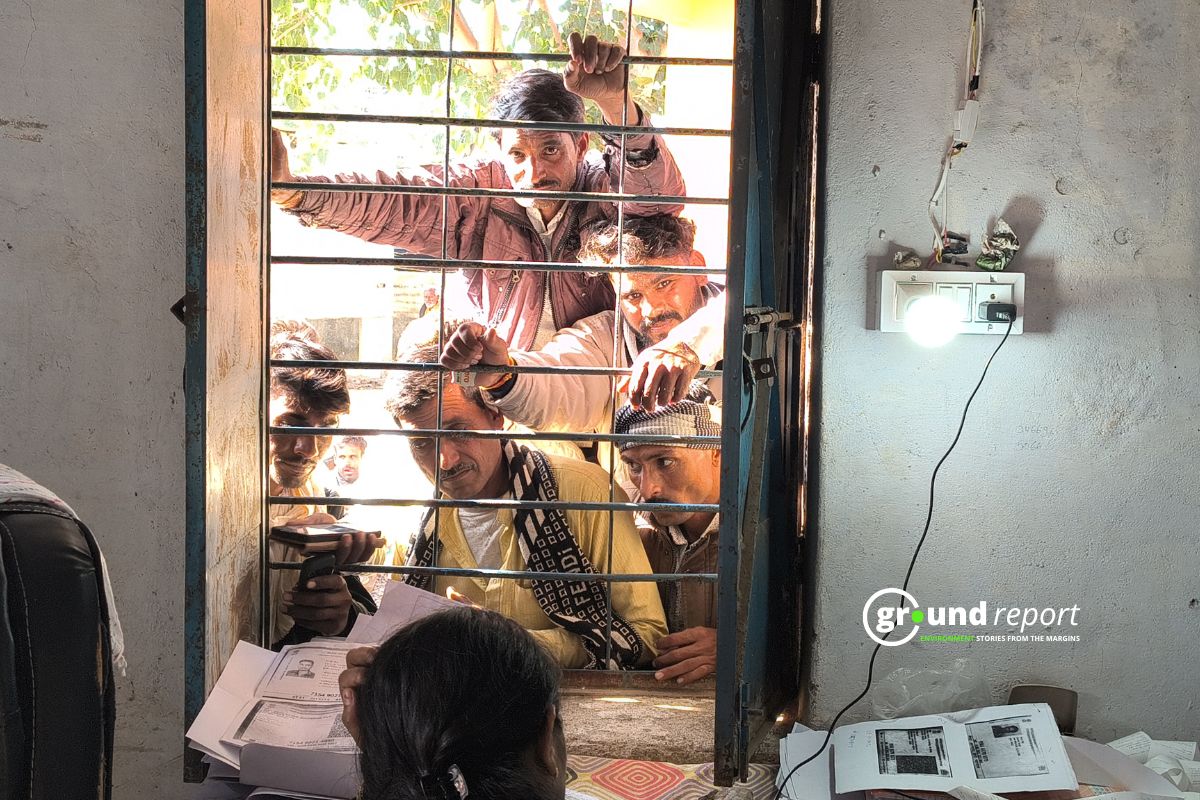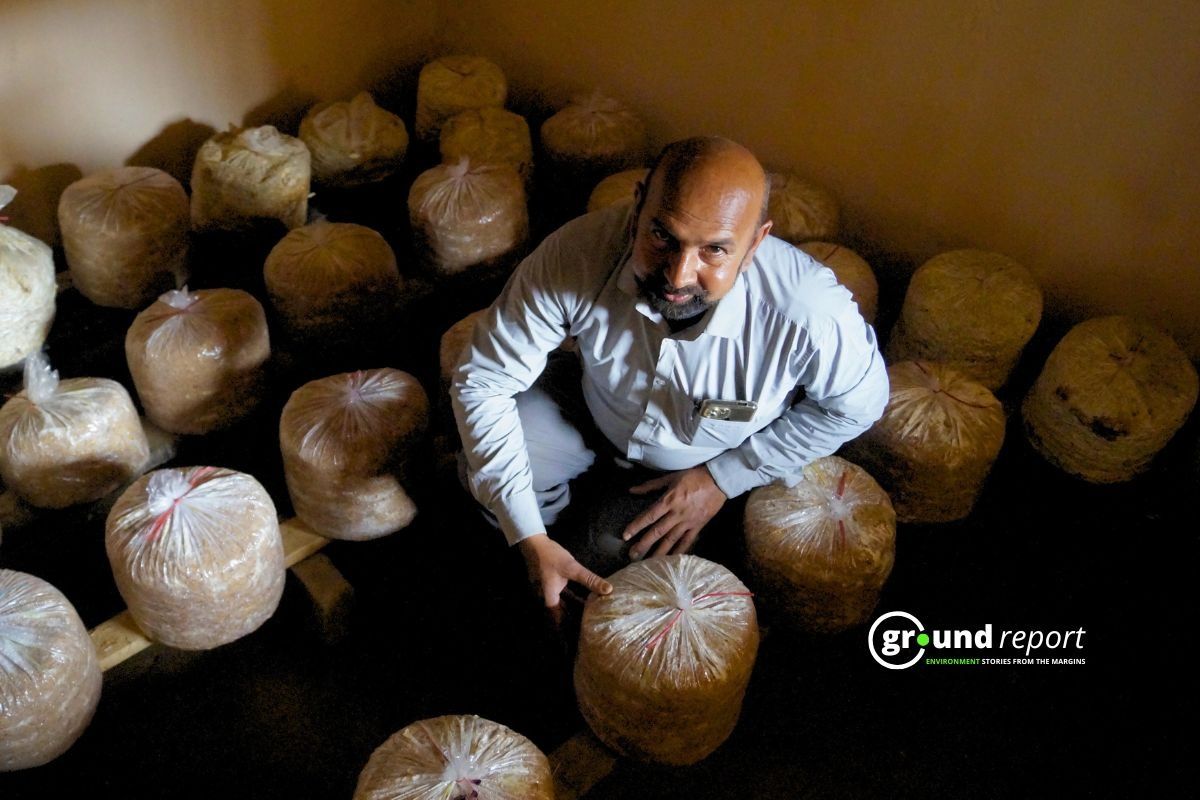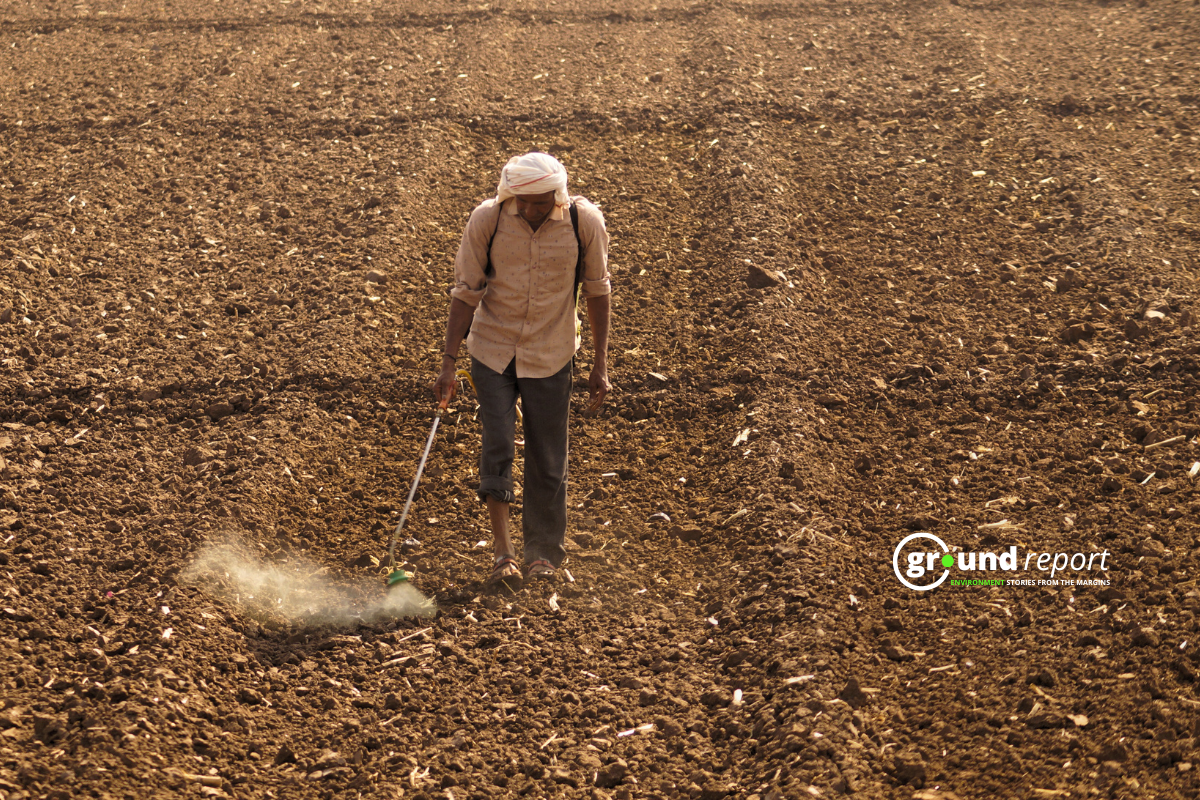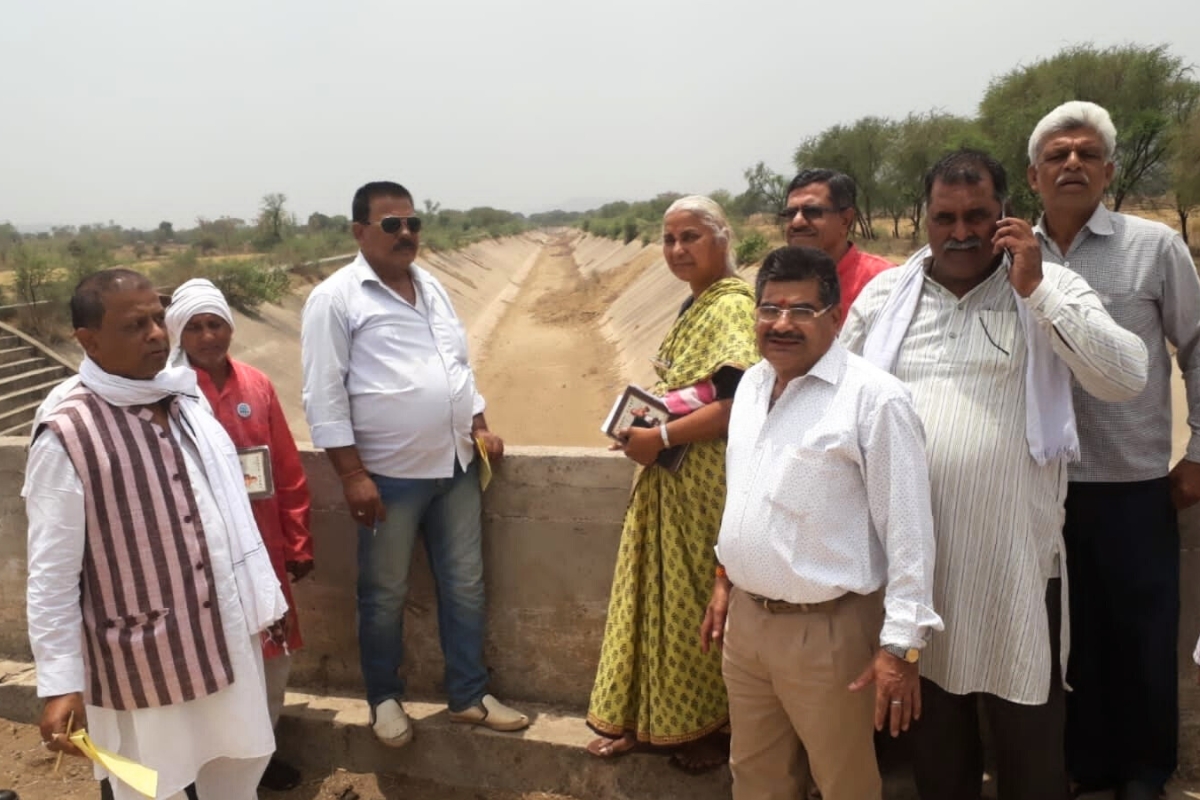Hariram Katare, a small- scale farmer from Hiraniya village in Raisen District, which is part of Bhopal Division of Madhya Pradesh, faces the harsh realities of farming that includes lack of adequate irrigation facilities. He worships the rain gods and prays with an unwavering hope for a good monsoon. His livelihood depends entirely on the one thing beyond his control— rainwater that helps irrigate his fields. Hariram belongs to the Bhilala tribe, a group within the Bhil community. Like many in his community, he lives below the poverty line, with limited resources to rely on.

Farmers wait for rainfall
He works on just 4 acres of land, 2 of which he owns and the other 2 he rents. Hariram doesn’t have a borewell. Without water, he can’t grow anything beyond paddy.
“I farm on 2 acres,” Hariram says as he surveys the dry soil. “During the Kharif season in June, I plant paddy across the entire field. But without water, my paddy cultivation relies solely on the rain. If I had water, I would have planted moong (a variety of pulses) as well.”
His access to irrigation is limited, and he often has to rely on neighbouring farmers for water, paying Rs 2,000 per acre every time. This dependence restricts his growth potential and adds unnecessary costs, which strain his already limited income.

“The paddy crop is the highest earner for us, but the lack of water affects not just our Kharif crops but also our Rabi crops,” he adds.
This year’s monsoon forecast is out—but Hariram has no clue. For farmers like him, official weather predictions hardly matter. He doesn’t rely on mobile apps or online updates. Instead, he trusts the village grapevine—forecasts shared over cups of tea and casual conversations.
Meanwhile, experts at the India Meteorological Department (IMD) are trying to paint a clearer picture. Their 2025 monsoon outlook brings a glimmer of hope: above-normal rainfall is expected, at 105% of the Long Period Average (LPA) of 868.6 mm—or roughly 87 cm.
For farmers like Hariram, it could mean a break from uncertainty—and maybe, just maybe, a better harvest.
“The forecast suggests a better-than-normal monsoon for most of India,” says M. Ravichandran, Secretary of the Ministry of Earth Sciences at IMD’s LRF press conference on April 15. “Some regions may experience below-normal rainfall, but the overall expectation is positive, with a forecast of 105% of LPA rainfall.”
While the IMD’s outlook is optimistic, private forecaster Skymet has offered a more cautious view. It predicts a ‘normal’ monsoon at 103% of the Long Period Average. The IMD and Skymet both base their forecasts on complex models, but their predictions differ slightly, especially in how they see the rainfall distribution across the country.
Despite this positive outlook, the unpredictability of rainfall, especially its timing and intensity, remains a significant concern.
“The monsoon forecast uses computer models that track how the ocean and atmosphere affect each other,” says Ravichandran. “One factor is snow cover. More snow in certain regions has a 33% link to better rainfall. But monsoon patterns are still hard to predict with full certainty.”
While some regions like Madhya Pradesh, Rajasthan, Maharashtra, and Chhattisgarh are expected to see above-normal rainfall, the distribution is uneven. In contrast, areas like Bihar, Jammu & Kashmir, Tamil Nadu, and parts of northeastern India may experience below-normal rainfall.
The IMD’s new monsoon forecast strategy, implemented in 2021, has improved the accuracy of predictions. The deviation between forecast and actual rainfall has dropped to just 2.7%, compared to a previous error rate of 7.5% in the 2017-2020 period.
In Madhya Pradesh, the state’s contingency plan offers a lifeline when rainfall is insufficient. The state has 152.05 lakh hectares of cultivable land, of which 126.86 lakh hectares are irrigated. When dry spells hit, the contingency plan becomes vital. But for many farmers, including those with borewells, timing still decides the outcome.
Rain timing affects yield
Rajbahor Patel, a farmer from Selpari village in Rewa District, knows the importance of timely rain. With five acres of land, he grows paddy, moong, and urad. Though he has access to a borewell, he admits that the key to his success lies in rainfall during the critical Kharif season.
“When the paddy plant begins to appear, that’s when we need rain the most,” says Rajbahor. “Last year, the rain didn’t come at the right time, and my yield dropped from 150 quintals to 100 quintals.”
For farmers like Rajbahor, the timing of the rain is just as important as the volume. A delay in rain can disrupt the crop growth cycle and result in lower yields. Despite having a borewell, Rajbahor relies heavily on rain during the critical stages of paddy growth.
“The IMD forecast suggests a slightly better monsoon this year, and hopefully, it will align with the critical rainfall periods,” says Jatin Singh, Managing Director of Skymet Weather Services. “The likelihood of a positive Indian Ocean Dipole (IOD) and ENSO-neutral conditions increases the chances of timely rains.”
However, Hariram’s situation is different. With no borewell and no reliable irrigation system, he relies entirely on rainfall—a gamble he takes every year. While this year’s forecast predicts normal rains, last year was a struggle. Faced with water scarcity, Hariram was forced to borrow water from his neighbours’ borewells just to keep his crops alive.
The farmer from Raisen district says he had to cultivate his land this year without any water. “Earlier, I used to buy water from nearby farmers. This time too, I tried to negotiate with a farmer for water, but he later backed out,” he says. With no water available, he suffered heavy losses. “There was no water at all this time. I’ve lost around ₹60,000 to ₹65,000,” he adds.
“It’s a tough time,” Hariram says. “Last year’s rainfall was poor, and there wasn’t enough water left to share. This year, the situation remained the same.”
Unpredictable forecast
While the IMD’s forecast of a better-than-normal monsoon offers some hope, it raises questions about the reliability of predictions. In recent years, extreme weather events such as floods and droughts have become more frequent, making the relationship between rainfall and agricultural success more complex. While the total number of rainy days in the monsoon has decreased, the intensity of rainfall has increased.

The challenges faced by farmers go beyond individual crops. India’s agriculture sector, which contributes nearly 20% to the nation’s GDP, heavily depends on the monsoon. Around 70-80% of farmers rely on rain for irrigation, making the monsoon a critical factor for food security, employment, and economic stability.
Farmers like Rajbahor and Hariram are all too aware of these risks. While they remain cautiously optimistic about the higher-than-normal rainfall predicted for this year, the lack of reliable irrigation infrastructure means that the unpredictability of rainfall is an ongoing concern.
Pawan Nagar, another farmer from Hiraniya village, practices organic farming on 4.5 acres. He remains skeptical about weather predictions. “When they predict, it doesn’t rain and when they don’t it rains,” Pawan says with a wry smile. “Last monsoon came late and left early. What they predicted didn’t happen.”
Pawan’s skepticism stems from the inconsistency between forecasts and actual weather patterns. Still, he holds hope that a good monsoon will give him a chance to get good yield. However, he knows that the true test of success lies not in forecasts but in the tangible results.
“I switched to organic farming to allow water to enter the soil and improve the water table,” Pawan explains. “I grow crops that need less water, so I’m not dependent on tube wells.”
Pawan, like Hariram, depends entirely on rainfall for his crops. He grows paddy, groundnut, sesame, and ambadi during the Kharif season. His organic practices, however, make him particularly vulnerable to fluctuations in water availability.
The IMD has stated that neutral conditions prevail over the equatorial Pacific region, similar to La Nina conditions. This year’s climate model forecasts indicate that neutral ENSO and Indian Ocean Dipole (IOD) conditions are likely to persist during the monsoon months.

Forecasts offer hope, not certainty
While the IMD predicts a better monsoon, farmers like Pawan remain cautious, knowing that erratic weather patterns have become the new norm. They’ve learned to expect the unexpected.
As Hariram, Rajbahor, Pawan, and many others await the monsoon, forecasts offer a flicker of hope. But they’ve learned that nature doesn’t always follow predictions. Without irrigation, timing is everything—and rainfall still decides their fate.
This year, Rajbahor will sow paddy again. If the rain comes late, he knows the yield will fall. A good monsoon brings a chance to recover. A bad one can wipe out an entire season.
Hariram still plans to grow paddy this June. Rajbahor will watch the skies when the paddy plant begin to appear. Pawan will keep sowing crops that need less water—no matter what the forecast says. They know what’s at stake.
On the edge of his field, Hariram presses his heel into the cracked soil and looks up.
Waiting, once again, for the clouds.
Support us to keep independent environmental journalism alive in India.
Keep Reading
‘Forever Chemicals’ found in all the world’s toilet paper
Trump shuts down staff helping families pay heating bills
Full list of words banned by Trump, including ‘Climate Change’
Oil companies seek Trump’s help to fight climate lawsuits & regulations
Follow Ground Report on X, Instagram and Facebook for environmental and underreported stories from the margins. Give us feedback on our email id greport2018@gmail.com.
Don’t forget to Subscribe to our weekly newsletter, Join our community on WhatsApp, and Follow our YouTube Channel








